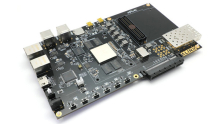作者:弱咩咩
版权声明:本文为博主原创文章,遵循 CC 4.0 BY-SA 版权协议,转载请附上原文出处链接和本声明。
本文链接:https://blog.csdn.net/qq_39229006/article/details/108821786
参考:https://www.xilinx.com/html_docs/xilinx2020_1/vitis_doc/dvy1591145410207...
开发环境:
操作系统:Ubuntu18.04
开发平台:Xilinx ZCU104
开发工具:Vitis 2020.1
镜像烧写工具:balenaEtcher
串口调试工具:minicom
1.准备工作
1.1安装OpenCL客户端驱动加载程序:
sudo apt-get install ocl-icd-libopencl1 opencl-headers ocl-icd-opencl-dev
1.2安装需要的软件包:
sudo add-apt-repository ppa:xorg-edgers/ppa
sudo apt-get update
sudo apt-get install libgl1-mesa-glx
sudo apt-get install libgl1-mesa-dri
sudo apt-get install libgl1-mesa-dev
sudo add-apt-repository --remove ppa:xorg-edgers/ppa
sudo apt install net-tools
sudo apt-get install -y unzip
sudo apt install gcc
sudo apt install g++
sudo apt install python
ln -s /usr/bin/python2 /usr/bin/python
1.3安装Vitis软件平台:
https://www.xilinx.com/support/download/index.html/content/xilinx/en/dow...
1.4安装Xilinx运行时:
https://china.xilinx.com/support/download/index.html/content/xilinx/zh/d...
1.5安装目标平台文件(ZCU104 Base 2020.1 ):
https://china.xilinx.com/support/download/index.html/content/xilinx/zh/d...
将文件解压并放到/opt/xilinx/platforms/目录下
1.6设置Vitis和XRT环境变量:
sudo gedit ./.bashrc
在文件末尾加上:
#setup XILINX_VITIS and XILINX_VIVADO variables
source
#setup XILINX_XRT
source /opt/xilinx/xrt/setup.sh
1.7下载嵌入式平台常用镜像:
https://china.xilinx.com/support/download/index.html/content/xilinx/zh/d...
下载文件:ZYNQMP通用映像(其他平台下载相应的镜像)
将文件解压到/opt/xilinx/目录下,解压后的文件名为xilinx-zynqmp-common-v2020.1,进入该文件,解压rootfs.ext4.gz文件
sudo gunzip ./rootfs.ext4.gz
解压后的文件名为:rootfs.ext4,接着为了得到平台所需要的sysroot文件,在当前文件目录下运行:
./sdk.sh -y -dir ./ -p
执行完成后得到文件夹ir。
至此,准备工作已经基本完成。
2.执行案例
命令行运行vitis,打开Vitis 2020.1,设置好Vitis工作空间后,点击File->new->Application Project…,在弹出界面点击Next,在Platform界面选择xilinx_zcu104_base_202010_1,点击Next,

输入项目名称:例如:test,点击Next,

在Application settings中设置Sysroot path、Root FS、Kernel Image:
Sysroot path:/opt/xilinx/xilinx-zynqmp-common-v2020.1/ir/sysroots/aarch64-xilinx-linux
Root FS:/opt/xilinx/xilinx-zynqmp-common-v2020.1/rootfs.ext4
Kernel Image:/opt/xilinx/xilinx-zynqmp-common-v2020.1/Image
点击Next,

选择Empty Application,点击Finish。
在test_system->test->src右键new->File,创建内核函数,输入文件名,如:kernel_test.cpp,需要注意内核函数名不能与关键词同名

kernel_test.cpp:
#define BUFFER_SIZE 256
extern "C" {
void kernel_test(
int* a,
int* b,
int* c,
const int n_elements)
{
#pragma HLS INTERFACE m_axi offset=SLAVE bundle=gmem port=a max_read_burst_length = 256
#pragma HLS INTERFACE m_axi offset=SLAVE bundle=gmem port=b max_read_burst_length = 256
#pragma HLS INTERFACE m_axi offset=SLAVE bundle=gmem1 port=c max_write_burst_length = 256
#pragma HLS INTERFACE s_axilite port=a bundle=control
#pragma HLS INTERFACE s_axilite port=b bundle=control
#pragma HLS INTERFACE s_axilite port=c bundle=control
#pragma HLS INTERFACE s_axilite port=n_elements bundle=control
#pragma HLS INTERFACE s_axilite port=return bundle=control
int arrayA[BUFFER_SIZE];
int arrayB[BUFFER_SIZE];
for (int i = 0 ; i < n_elements ; i += BUFFER_SIZE)
{
int size = BUFFER_SIZE;
//boundary check
if (i + size > n_elements) size = n_elements - i;
//Burst reading A and B
readA: for (int j = 0 ; j < size ; j++) {
#pragma HLS pipeline ii = 1 rewind
arrayA[j] = a[i+j];
arrayB[j] = b[i+j];
}
//Burst reading B and calculating C and Burst writing
// to Global memory
vadd_wrteC: for (int j = 0 ; j < size ; j++){
#pragma HLS pipeline ii = 1 rewind
c[i+j] = arrayA[j] + arrayB[j];
}
}
}
}
该内核函数简单实现了一个c=a+b的功能,运用了HLS的一些语法和优化。
然后再用一样的方法创建主机程序:host.cpp与host.h
host.cpp:
#include
#include
#include
#include "host.h"
static const int DATA_SIZE = 4096;
static const std::string error_message =
"Error: Result mismatch:\n"
"i = %d CPU result = %d Device result = %d\n";
int main(int argc, char* argv[]) {
//TARGET_DEVICE macro needs to be passed from gcc command line
if(argc != 2) {
std::cout << "Usage: " << argv[0] <<"
return EXIT_FAILURE;
}
char* xclbinFilename = argv[1];
// Compute the size of array in bytes
size_t size_in_bytes = DATA_SIZE * sizeof(int);
// Creates a vector of DATA_SIZE elements with an initial value of 10 and 32
// using customized allocator for getting buffer alignment to 4k boundary
std::vector<:device> devices;
cl::Device device;
std::vector<:platform> platforms;
bool found_device = false;
//traversing all Platforms To find Xilinx Platform and targeted
//Device in Xilinx Platform
cl::Platform::get(&platforms);
for(size_t i = 0; (i < platforms.size() ) & (found_device == false) ;i++){
cl::Platform platform = platforms[i];
std::string platformName = platform.getInfo
if ( platformName == "Xilinx"){
devices.clear();
platform.getDevices(CL_DEVICE_TYPE_ACCELERATOR, &devices);
if (devices.size()){
device = devices[0];
found_device = true;
break;
}
}
}
if (found_device == false){
std::cout << "Error: Unable to find Target Device "
<< device.getInfo
return EXIT_FAILURE;
}
// Creating Context and Command Queue for selected device
cl::Context context(device);
cl::CommandQueue q(context, device, CL_QUEUE_PROFILING_ENABLE);
// Load xclbin
std::cout << "Loading: '" << xclbinFilename << "'\n";
std::ifstream bin_file(xclbinFilename, std::ifstream::binary);
bin_file.seekg (0, bin_file.end);
unsigned nb = bin_file.tellg();
bin_file.seekg (0, bin_file.beg);
char *buf = new char [nb];
bin_file.read(buf, nb);
// Creating Program from Binary File
cl::Program::Binaries bins;
bins.push_back({buf,nb});
devices.resize(1);
cl::Program program(context, devices, bins);
// This call will get the kernel object from program. A kernel is an
// OpenCL function that is executed on the FPGA.
cl::Kernel krnl_vector_add(program,"kernel_test");
// These commands will allocate memory on the Device. The cl::Buffer objects can
// be used to reference the memory locations on the device.
cl::Buffer buffer_a(context, CL_MEM_READ_ONLY, size_in_bytes);
cl::Buffer buffer_b(context, CL_MEM_READ_ONLY, size_in_bytes);
cl::Buffer buffer_result(context, CL_MEM_WRITE_ONLY, size_in_bytes);
//set the kernel Arguments
int narg=0;
krnl_vector_add.setArg(narg++,buffer_a);
krnl_vector_add.setArg(narg++,buffer_b);
krnl_vector_add.setArg(narg++,buffer_result);
krnl_vector_add.setArg(narg++,DATA_SIZE);
//We then need to map our OpenCL buffers to get the pointers
int *ptr_a = (int *) q.enqueueMapBuffer (buffer_a , CL_TRUE , CL_MAP_WRITE , 0, size_in_bytes);
int *ptr_b = (int *) q.enqueueMapBuffer (buffer_b , CL_TRUE , CL_MAP_WRITE , 0, size_in_bytes);
int *ptr_result = (int *) q.enqueueMapBuffer (buffer_result , CL_TRUE , CL_MAP_READ , 0, size_in_bytes);
//setting input data
for(int i = 0 ; i< DATA_SIZE; i++){
ptr_a[i] = 10;
ptr_b[i] = 20;
}
// Data will be migrated to kernel space
q.enqueueMigrateMemObjects({buffer_a,buffer_b},0/* 0 means from host*/);
//Launch the Kernel
q.enqueueTask(krnl_vector_add);
// The result of the previous kernel execution will need to be retrieved in
// order to view the results. This call will transfer the data from FPGA to
// source_results vector
q.enqueueMigrateMemObjects({buffer_result},CL_MIGRATE_MEM_OBJECT_HOST);
q.finish();
//Verify the result
int match = 0;
for (int i = 0; i < DATA_SIZE; i++) {
int host_result = ptr_a[i] + ptr_b[i];
if (ptr_result[i] != host_result) {
printf(error_message.c_str(), i, host_result, ptr_result[i]);
match = 1;
break;
}
}
q.enqueueUnmapMemObject(buffer_a , ptr_a);
q.enqueueUnmapMemObject(buffer_b , ptr_b);
q.enqueueUnmapMemObject(buffer_result , ptr_result);
q.finish();
std::cout << "TEST " << (match ? "FAILED" : "PASSED") << std::endl;
return (match ? EXIT_FAILURE : EXIT_SUCCESS);
}
host.h:
#pragma once
#define CL_HPP_CL_1_2_DEFAULT_BUILD
#define CL_HPP_TARGET_OPENCL_VERSION 120
#define CL_HPP_MINIMUM_OPENCL_VERSION 120
#define CL_HPP_ENABLE_PROGRAM_CONSTRUCTION_FROM_ARRAY_COMPATIBILITY 1
#include
//Customized buffer allocation for 4K boundary alignment
template
struct aligned_allocator
{
using value_type = T;
T* allocate(std::size_t num)
{
void* ptr = nullptr;
if (posix_memalign(&ptr,4096,num*sizeof(T)))
throw std::bad_alloc();
return reinterpret_cast
}
void deallocate(T* p, std::size_t num)
{
free(p);
}
};
该主机函数负责将内核函数传送到设备上执行,并验证结果是否正确。
在Application Project Settings界面,添加Hardware Funcation,点击 ,添加二进制容器,点击
,添加二进制容器,点击 ,添加kernel_test函数,并设置Active build configuration:Hardware
,添加kernel_test函数,并设置Active build configuration:Hardware

在Assistant界面右键Hardware->Build进行编译,编译成功后在工程目录下生成如下文件:

其中sd_card.img用来烧写进SD卡的镜像
运用镜像烧写工具将sd_card.img烧写进SD卡,插上SD卡启动ZCU104,通过串口连接将显示以下信息:

执行以下命令:
cd /mnt/sd-mncblk0p1
source ./init.sh
运行程序:
./test binary_container_1.xclbin
显示如下:

显示TEST PASSED,成功





